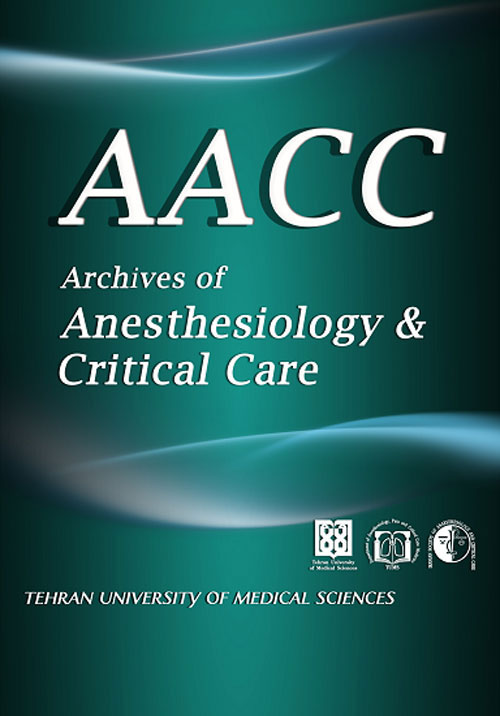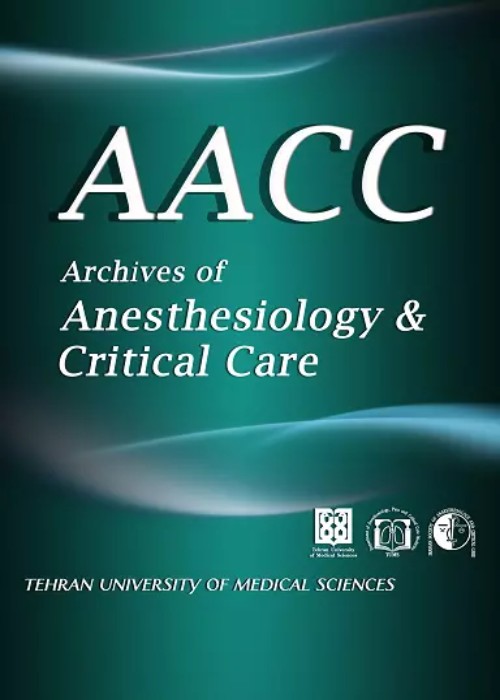فهرست مطالب

Archives of Anesthesiology and Critical Care
Volume:5 Issue: 4, Autumn 2019
- تاریخ انتشار: 1398/08/15
- تعداد عناوین: 6
-
-
Pages 110-114Background
Human body exposure to any trauma, such as surgical procedures stimulates neurohumoral and catabolic responses. This process includes; increased metabolism of proteins, carbohydrates, and lipids along with water and sodium retention, resistance to insulin, and furthermore, increased levels of blood sugar. One of the factors that has been assumed to influence postoperative complications is preoperative fasting duration.
MethodsIn this double-blind, randomized clinical trial, 90 patients aged 18 to 70 years, referred for elective surgery were randomly allocated to three groups of 30. Group A (IV-CHO): Within 6 hours of fasting, this group was treated with one gram per kilogram of carbohydrate dissolved in 50 ml of normal saline and then injected. Group B (Oral-CHO): Within 6 hours of fasting, this group was treated with one gram per kilogram of carbohydrate dissolved in 50 ml of normal saline and then administered orally. Group C (Ni-CHO): Within 6 hours of fasting, 50 ml of normal saline was administrated orally in this group. Patients were requested to score their pain following the surgical procedure using a scale of 0-10 scoring (VAS). Besides, the [need for] analgesics before [transfer] to the general ward, at the end of recovery stay were recorded as well.
ResultsAccording to the results of our study, evaluation (and) comparison of VAS scores was significantly different among groups prior to the surgical procedure (p=0.004). Postoperative pain assessments showed significant difference among groups (p=0.002). Scheffe test showed significantly less pain score in the IV-CHO group than the oral-CHO (p=0.029) and control group (p=0.010).
ConclusionPreoperative use of carbohydrate whether intravenously or orally could efficiently affect postoperative adverse effects in a positive manner while some aspects were not statistically changed to a more desirable status.
Keywords: Intravenous carbohydrate, Oral carbohydrate, Post-anesthesia care unit -
Pages 115-117Background
Memory has an important role in our social life. General anesthesia has long been known to negatively affect the recent memory. It is also necessary to study the recent memory changes upon regional anesthesia.
MethodsThis study is cohort, before-after type, which was accomplished at Imam Khomeini hospital. The recent memory was evaluated before and after regional anesthesia using Wechsler memory scale-revised V. The obtained data were analyzed using SPSS 25 software to calculate median, mean, standard deviation and p-value.
Results220 women and 180 men with an average age of 42.7 years old were interviewed, among which 248 patients had accompanied diseases and/or history of former surgeries. It was found that recent memory function reduces upon regional anesthesia. Moreover, different aspects of memory do not exhibit similar extent of sensitivity to anesthesia; logical memory and number repeat reduced pronouncedly.
ConclusionRegional Anesthesia causes recent memory loss and cognitive disorders.
Keywords: Regional anesthesia, Recent memory, Wechsler memory scale-revised V -
Pages 118-121Background
Transforaminal epidural steroid injections (both lumbar and cervical) are used in many treatments. The use of this method in the control and treatment of radicular pain is intensively expanding. In this method, and for the purpose of implementing the injection process, the needle is inserted from the posterolateral of the spine and steroids injected. Steroids include a wide range of medications, many of which are used in modern medicine. Research on these drugs is still underway. The use of Dexamethasone in lumbar transforaminal epidural injections and the study of complications caused by it have been less studied. In some previous studies, use of this steroid for lumbar transforaminal epidural injections has been mentioned.
MethodsThe present study was conducted in Shohada-e-Tajrish Hospital in Tehran. Patients over 18 years of age who were afflicted with Lumbar stenosis Foraminal (Diagnosis by MRI) and had associated with Radio Kevlar pain were selected. These patients are divided into two groups of 14. In a group, 2.5 cc dexamethasone 8 mg / cc diluted with 2.5 cc distilled water was injected. In the second group, 2.5 cc triamcinolone 40 mg / cc was injected with 2.5 cc distilled water in a volume of 5 cc. In order to evaluate and compare the effects of these two steroids on the patients, the results of the questionnaire were evaluated by statistical techniques and software SPSS 21.
ResultsThe results showed that the use of dexamethasone had far more successful effects than another drug. However, the above conclusion is a relative conclusion and absolute expression is not possible. Pharmaceutical manifestations are the result of patient reactions. Thus, doing similar research and comparing drug performance should be put on the agenda of various research and medical teams.
ConclusionUse of Dexamethasone had far more successful effects than Triamcinolone on epidural steroid injections.
Keywords: Transforaminal, Epidural, Steroid, Dexamethasone, Triamcinolone -
Pages 122-127Background
Despite the growing advancements of surgical and anesthetic techniques resulting in decreased morbidity and mortality, the period before surgery remains stressful for most patients. Considering the adverse effect of preoperative anxiety on anesthesia and surgery outcomes, we conducted this study to evaluate the level of anxiety in the anesthesia clinic among Iranian patients undergoing surgery and also to determine its associated factors.
MethodsThis was a cross-sectional study performed on 231 patients admitted to the anesthesia clinic of Imam Khomeini hospital, Tehran, Iran. Data were collected by using a three-part questionnaire consisting of demographic data, clinical findings and the translated version of Spielberger state-trait anxiety inventory (STAI). Chi-square test and binary logistic regression model were performed for univariate and multivariate analysis, respectively. A p-value< 0.05 was considered statistically significant.
ResultsThe mean (SD) score for state and trait anxiety were 39.8 (13.4) and 36.5 (12.2), respectively. A significant association was seen between state anxiety and age, gender, occupation, level of education, marital status, patients’ awareness of type of anesthesia and patients’ awareness of anesthesia adverse events (p< 0.05). The most predictive factors for state anxiety were age, patients’ awareness of anesthesia adverse events and female gender, and for trait anxiety these factors were age, place of residence and female gender.
ConclusionScreening for anxiety and identifying individuals vulnerable to preoperative anxiety (e.g. younger patients, females…) can help reduce undesirable surgery outcomes and their economic burden on the healthcare system.
Keywords: Anesthesia, Preoperative anxiety, Spielberger questionnaire, Spielberger state-trait anxiety inventory (STAI), Surgery -
Pages 128-132Background
At present, no documented anesthetic technique exists for use in liver transplant surgery. Presence of some controversies in anesthesia plan led us to compare effects of inhaled and intravenous anesthetics in liver transplant surgery.
MethodsAll those brain dead patients who met the criteria of organ donation were included in the study. The donor's liver is matched with the recipient according to our liver transplant protocols and assigned consecutively to the recipients. In this study 78 patients who met the inclusion criteria, were divided into two groups.All patients in group 1 were anesthetized with inhalation of sevoflurane and patients in group 2 were anesthetized with the IV injection of propofol. Percent of sevoflurane in inhaled gases and IV infusion dose of propofol was determined by a BIS guide to keep BIS between 40 and 45. Patients were monitored by NIBP, ECG, CO – Oximetry and BIS before and during induction of anesthesia. An arterial line from radial artery and Swan–Ganz–Catheter from right internal jugular vein were inserted for all patients.
ResultsMean of PCO2, PO2 and HCO3 were different between 2 groups (p=<0.05) and were higher in propofol group. Also, mean of Na and K were different in both groups and were higher in sevoflurane group, and no other significant differences found.
ConclusionThe results showed that the effect of propofol and sevoflurane on hemodynamics, coagulation status during liver transplant anesthesia, and hepatic and renal function of the patients after liver transplant is the same.
Keywords: Liver transplantation, Propofol, Sevoflurane, Hemodynamics, Coagulation status -
Pages 133-134
Anaesthesia management is always challenging in a patient who comes in emergency with multiple comorbidities. When we have to choose type of anaesthesia in such patients we have to keep in mind its adverse effects on various organs and cardiovascular system particularly in hemodynamically unstable patients. Epidural and spinal anaesthesia in these cases have their own complications on hemodynamics of the patient. Epidural Volume Expansion (EVE) technique is a known technique that allows to achieve surgical anaesthesia level with smaller dose than the conventional procedure. We report successful management of an emergency case with EVE technique.
Keywords: Epidural volume expansion, Severe anaemia, Haemodialysis


